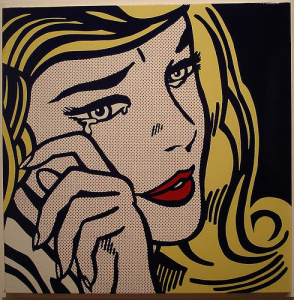So when my mom asked me if I wanted to meet my real dad sometime, I said no. I don't want things to become complicated between me and my stepdad. And I also don't want things to become weird and awkward just because there's some other dad on an old photograph. I like things very much the way they are.
But the whole thing made me realize something else. My mom almost never cries. She's one of those people who think that 'keeping a stiff upper lip' is more than just a saying. I never understood what 'keeping a stiff upper lip' really means. I think that people would look very weird if they were to do it properly.
My mom says it has to do with manners. And that's why she's always pulling herself together so much. (Have a look at this article in the Telegraph to find out a little more about British stiff-upper-lipness.)
Anyway. When she showed me those pictures of my dad, I thought it was strange how she lost a bit of her stiff upper lip. I had never seen her cry before. I think it had to do with my other dad running off with that woman. But I also thought it would be best not to ask her any more questions. I know that crying makes her feel very uncomfortable.
I'm sure my mom will tell me more about my other dad when she's ready. So - in the meantime - I wanted to find out why sad memories can make us cry so much. And I also wanted to know what tears are really made of. So here it goes...
Biologists distinguish between three different types of tears. These are basal tears, reflex tears and psychic or emotional tears. The basal tears are the ones that are always there to protect the eye. When we blink, they get washed out of something called the lacrimal punctum. It's a pretty interesting process because every time we blink we also wash out the old layer of tears through something called the inferior lacrimal canal. It's a little tunnel that transports our old tears through to our nose. (Check out this image on Wikipedia for a detailed description of the tear system in our eyes.)
Our reflex tears are the ones we shed when we've got something in our eye (such as a hair or dust). They are also the reason we get so teary every time someone cuts an onion. Onion vapors are really irritant for our eyes, so our eyes try to wash away the sulfenic acids they produce by generating more and more teary lubricant. (If you're into chemistry, you'll be interested to know that the sulfenic acid of an onion is turned into a special kind of sulfenic acid named 1-propenesulfenic acid, which then reacts with an enzyme to create syn-propanethial-S-oxide. Click on the link for a full description of this and to see what it looks like).
But I think the third type of our tears is the most interesting one. When we cry because we're sad or emotional, we activate all kinds of physical reactions. Reflex tears and basal lubrication of the eyes is pretty straightforward. But when we have emotional stress or when we feel fear, our limbic system, our whole muscular system and our brain get involved. (It's actually not the whole brain but only a little part called 'hypothalamus' that gets involved - click here if you're interested in learning more about the hypothalamus and how it functions.)
Before I ask my mom some more questions, I think I'll have to tell her that it's OK to cry. You don't always have to keep a stiff upper lip. Scientists say crying helps to calm ourselves (I even found a blog on a site called Psychcentral that's called 'Seven Good Reasons to Cry'). It tells others about our difficulties and it strengthens our social ties. So it's OK for my mom to feel sad that our first dad left us for another woman. There's nothing wrong with that.
And while I'm on it, I will also tell my (step)dad. He still thinks that men don't cry. But I've seen him fall apart every time he watches a romantic comedy...
Check out this video I found on psychic crying by the 'Talk Nerdy To Me' guys. It's pretty interesting.
I took the small picture of the crying woman from a blog called Science inspiration. The stiff upper lippy picture came from the article on stiff upper lips on the Telegraph's website. The crying girl picture at the beginning of my post was made by Roy Lichtenberg in 1964.
The crying boy was photographed by someone called Jill Greenberg. I found him on a blog post praising her work on reelphoto.blogspot.co.uk.




No comments:
Post a Comment